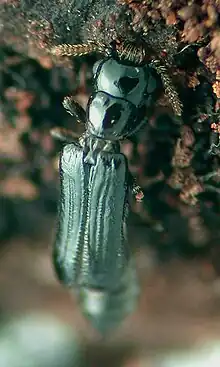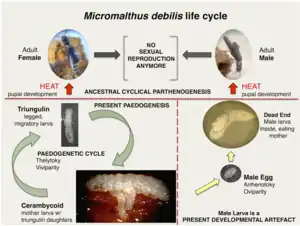| Telephone-pole beetle Temporal range: | |
|---|---|
 | |
| Scientific classification | |
| Domain: | Eukaryota |
| Kingdom: | Animalia |
| Phylum: | Arthropoda |
| Class: | Insecta |
| Order: | Coleoptera |
| Suborder: | Archostemata |
| Family: | Micromalthidae Barber, 1913 |
| Genus: | Micromalthus LeConte, 1878 |
| Species: | M. debilis |
| Binomial name | |
| Micromalthus debilis LeConte, 1878 | |
| Other species | |
| |
| Synonyms[1] | |
|
Micromalthus anansi Perkovsky, 2008 | |
The telephone-pole beetle (Micromalthus debilis) is a beetle native to the eastern United States, and the only living representative of the otherwise extinct family Micromalthidae. They have an unusual life cycle involving asexually reproducing (parthenogenetic) female larvae, as well as non-functional "ghost adults".
Taxonomy
Classification of M. debilis was historically controversial and unsettled. The species, first reported by John Lawrence LeConte in 1878, was long considered one of the Polyphaga, and placed in the Lymexylidae or Telegeusidae, or as a family within the Cantharoidea. However, characteristics of larvae, wings, and male genitalia show that it is in the suborder Archostemata, where it has been placed since 1999.[2]
Morphology and life cycle

The adult beetle is elongated, ranging from 1.5 to 2.5 mm (0.059 to 0.098 in) in length, and a dark brown to blackish color, with brownish-yellow legs and antennae. The head is larger than the thorax, with large eyes protruding from either side.
The larvae are wood-borers that feed on moist and decaying chestnut and oak logs. They have also been reported as causing damage to buildings and poles (hence the name).
The life cycle is unusual in that the cerambycoid stage of the larva gives birth via parthenogenesis to caraboid larvae, or more rarely, develops into an adult female. Adult males also rarely develop, consuming their mother from the inside. Development into adults is triggered by high temperatures, but this also results in high mortality of larvae. The adult females have a lifespan of six days, while males only live for around 12 hours, with a strongly biased sex ratio towards females. The adults of both sexes are sterile, and are vestigial remnants of a time when the life cycle involved sexual reproduction. The loss of sexual reproduction is likely associated with its infection by Wolbachia bacteria.[3]
In an experimental study, heating was used to generate substantial numbers of adults to simulate the now non-functional adult life cycle. This species showed sex-role reversal. Females preferred to mate with males that originated from a different log than the one from which they originated, with a "dance" motion involving shaking of their abdomens and beating of their wings likely used to reject males. Females also competed for and initiated interactions with males, grasping the males' genitalia with their own.[3]
Evolutionary history
Genetic studies have placed Micromalthus as more closely related to Ommatidae than to Cupedidae within Archostemata.[4] A close relationship between Ommatidae and Micromalthidae is supported by several morphological characters, including those of the mandibles and male genitalia.[5] A close relationship to the enigmatic family Crowsoniellidae has been suggested by some sources.[6] The oldest record of Micromalthidae is Archaeomalthus from the Upper Permian of Russia around 252 million years old, which is morphologically similar in many respects to Micromalthus including an only weakly sclerotised body.[7] Several other fossil genera of the family are known including Cretomalthus, known from a larva found in Early Cretaceous (Barremian) Lebanese amber,[8] as well as Protomalthus from the mid-Cretaceous (Albian-Cenomanian) Burmese amber of Myanmar.[9]
Fossils of Micromalthus are known from the Miocene aged Dominican amber (adults and larvae, which were found to not be distinguishable from the living species[1]) and Mexican amber (larvae), the late Eocene aged Rovno amber of Ukraine (Micromalthus priabonicus),[10] and the early Eocene (Ypresian) aged Oise amber of France (Micromalthus eocenicus).[11] A possible specimen of Micromalthus is known from Burmese amber,[12] but the poor preservation of the specimen makes the assignment tentantive.[9]
Status
Reports of the species are infrequent and it is unknown whether they are rare, or common and unrecognized. A recent study by Bertone et al. (2016)[13] found telephone-pole beetles in a survey of the indoor arthropod fauna in 50 houses located in and around Raleigh, North Carolina.[14] A recent survey found that the species had spread to every continent except Australia. With finds in South Africa, Hong Kong, Belize,[15] Cuba, Brazil, Japan, Hawaii, Italy and Austria, the dispersal is likely connected to the timber trade.[16]
References
- 1 2 Hörnschemeyer, Thomas; Wedmann, Sonja; Poinar, George (February 2010). "How long can insect species exist? Evidence from extant and fossil Micromalthus beetles (Insecta: Coleoptera): SPECIES LONGEVITY IN MICROMALTHUS (COLEOPTERA)". Zoological Journal of the Linnean Society. 158 (2): 300–311. doi:10.1111/j.1096-3642.2009.00549.x. (Erratum: doi:10.1111/j.1096-3642.2010.00702.x)
- ↑ Ross H. Arnett, Jr. and Michael C. Thomas, American Beetles (CRC Press, 2001), chap. 2
- 1 2 Perotti, M. Alejandra; Young, Daniel K.; Braig, Henk R. (June 2016). "The ghost sex-life of the paedogenetic beetle Micromalthus debilis". Scientific Reports. 6 (1): 27364. Bibcode:2016NatSR...627364P. doi:10.1038/srep27364. ISSN 2045-2322. PMC 4895236. PMID 27270667.
- ↑ McKenna, Duane D.; Shin, Seunggwan; Ahrens, Dirk; Balke, Michael; Beza-Beza, Cristian; Clarke, Dave J.; Donath, Alexander; Escalona, Hermes E.; Friedrich, Frank; Letsch, Harald; Liu, Shanlin (2019-12-03). "The evolution and genomic basis of beetle diversity". Proceedings of the National Academy of Sciences. 116 (49): 24729–24737. Bibcode:2019PNAS..11624729M. doi:10.1073/pnas.1909655116. ISSN 0027-8424. PMC 6900523. PMID 31740605.
- ↑ Hörnschemeyer, Thomas (July 2009). "The species-level phylogeny of archostematan beetles-where do Micromalthus debilis and Crowsoniella relicta belong?". Systematic Entomology. 34 (3): 533–558. doi:10.1111/j.1365-3113.2009.00476.x. S2CID 84795808.
- ↑ Li, Yan-Da; Tihelka, Erik; Yamamoto, Shûhei; Newton, Alfred F.; Xia, Fang-Yuan; Liu, Ye; Huang, Di-Ying; Cai, Chen-Yang (2023-08-22). "Mesozoic Notocupes revealed as the sister group of Cupedidae (Coleoptera: Archostemata)". Frontiers in Ecology and Evolution. 11. doi:10.3389/fevo.2023.1015627. ISSN 2296-701X.
- ↑ Yan, Evgeny Viktorovich; Beutel, Rolf Georg; Lawrence, John Francis; Yavorskaya, Margarita Igorevna; Hörnschemeyer, Thomas; Pohl, Hans; Vassilenko, Dmitry Vladimirovich; Bashkuev, Alexey Semenovich; Ponomarenko, Alexander Georgievich (2020-09-13). "Archaeomalthus -(Coleoptera, Archostemata) a 'ghost adult' of Micromalthidae from Upper Permian deposits of Siberia?". Historical Biology. 32 (8): 1019–1027. doi:10.1080/08912963.2018.1561672. ISSN 0891-2963. S2CID 91721262.
- ↑ Song, Zhenyu; Zhao, Xianye; Jarzembowski, Edmund A.; Xiao, Chuantao (2022-09-01). "Overview of and taphonomic bias in Archostemata (Insecta: Coleoptera) from Cretaceous amber". Palaeontographica Abteilung A. 323 (4–6): 119–137. Bibcode:2022PalAA.323..119S. doi:10.1127/pala/2022/0131. ISSN 0375-0442. S2CID 250394641.
- 1 2 Tihelka, Erik; Huang, Diying; Cai, Chenyang (March 2020). "A new genus and species of Micromalthidae from Burmese amber (Coleoptera: Archostemata)". Earth and Environmental Science Transactions of the Royal Society of Edinburgh. 111 (1): 39–46. doi:10.1017/S1755691019000185. ISSN 1755-6910. S2CID 210267382.
- ↑ Perkovsky, E. E. (May 2016). "A new species of Micromalthidae (Coleoptera) from the Rovno amber: 1. Adult morphology". Paleontological Journal. 50 (3): 293–296. doi:10.1134/S0031030116030047. ISSN 0031-0301. S2CID 89095000.
- ↑ Kirejtshuk, Alexander G.; Nel, André; Collomb, François-Marie (January 2010). "New Archostemata (Insecta: Coleoptera) from the French Paleocene and Early Eocene, with a note on the composition of the suborder". Annales de la Société Entomologique de France. N.S. 46 (1–2): 216–227. doi:10.1080/00379271.2010.10697661. ISSN 0037-9271. S2CID 55400656.
- ↑ Yamamoto, Shûhei (2021-07-03). "The extant telephone-pole beetle genus Micromalthus discovered in mid-Cretaceous amber from northern Myanmar (Coleoptera: Archostemata: Micromalthidae)". Historical Biology. 33 (7): 941–948. doi:10.1080/08912963.2019.1670174. ISSN 0891-2963. S2CID 208560568.
- ↑ Bertone, MA; Leong, M; Bayless, KM; Malow, TL; Dunn, RR; Trautwein, MD (19 January 2016). "Arthropods of the great indoors: characterizing diversity inside urban and suburban homes". PeerJ. 4: e1582. doi:10.7717/peerj.1582. PMC 4727974. PMID 26819844.
- ↑ Milman, Oliver (19 January 2016). "Hundreds of tiny spiders, lice and more crawling through US homes, study says". The Guardian. Retrieved 19 January 2016.
Matthew Bertone, an entomologist at North Carolina State University, said he was amazed at the variety of species found in what he stressed were 'clean and normal' homes in Raleigh, North Carolina. 'We were pretty surprised with what we found, such as the smallest wasp in the world, which is just 1mm long,' he said. 'I saw a lot of things in homes that I had never seen in the wild before, things we've previously tried to trap. There is a weird species of beetle, called telephone pole beetles, where the babies can produce babies. And tiny crickets called ant-loving ants because they are found near ant nests. I've never seen one of those before.'
- ↑ Philips, T. Keith (2001). "A Record of Micromalthus debilis (Coleoptera: Micromalthidae) from Central America and a Discussion of Its Distribution". The Florida Entomologist. 84 (1): 159–160. doi:10.2307/3496680. ISSN 0015-4040. JSTOR 3496680.
- ↑ Ruzzier, Enrico; Colla, Andrea (2019-06-26). "Micromalthus debilis LeConte, 1878 (Coleoptera: Micromalthidae), an American wood-boring beetle new to Italy". Zootaxa. 4623 (3): 589–594. doi:10.11646/zootaxa.4623.3.12. ISSN 1175-5334. PMID 31716256. S2CID 198251566.
External links
 Media related to Micromalthus debilis at Wikimedia Commons
Media related to Micromalthus debilis at Wikimedia Commons Data related to Micromalthus debilis at Wikispecies
Data related to Micromalthus debilis at Wikispecies- Tree of Life page, with pictures and video
- The life cycle of Micromalthus debilis